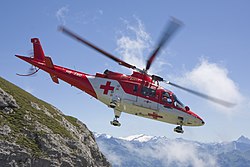Ultralight helicopters are classified as ultralight aircraft by the FAA and as Very Light Rotorcraft (VLR) by the EASA. [1] [2]
| Type | Country | Notes |
|---|---|---|
| CG 600 | China | [3] |
| Tongqi Coax Copter | China | Single seat coaxial heli [4] |
| Rudimentary Coax Copter | China | Single seat coaxial heli [5] |
| Circus Performer's | China | Single seat coaxial heli [6] |
| Yellow CoAx Heli | China | Single seat coaxial heli [7] |
| Ultrasport 254 | United States | First ultralight |
| Curti Zefhir | Italy | |
| DF Helicopters DF334 | Italy | |
| SKT Helicopters/ DKT07 | Swiss / Italy / Belgium | [8] |
| Micron Coax Helicopter | Russia | |
| SCH 1A Miro CRV | Slovenia | |
| RT 216 | China / Germany | [9] |
| Evocopter | Germany | [10] |
| RotorSchmiede VA115 | Germany | Coaxial Single Seater [11] |
| RotorSchmiede VA250 | Germany | Coaxial Double Seater [12] |
| EDM Aerotec CoAX 2D/2R | Germany | [13] |
| Youngcopter Neo | Germany | NOTAR |
| Heli-Sport CH-7 | Argentina / Italy | HeliLight ULM |
| JH-2 | China | Dynali H3 & AK1-3 parts [14] |
| Gray Zhu bi-place heli | China | 2 seat bi-place copter [15] |
| Lightest coaxial heli | China | Single seat coaxial heli [16] |
| Coaxial black heli | China | Coaxial Single Seater [17] |
| Shandong coax heli | China | Coaxial Single Seater [18] |
| Guo Leiting's Coax | China | Yuncheng Farmer's Chopper |
| Shantou Copters | China | Homebuilt Helis by Farmer |
| Chen Ruihua Jiangsu | China | Coaxial Single Seater [19] |
| Coaxial heli Zhuzhou | China | Coaxial Single Seater [20] |
| Agricultural coaxial heli | China | [21] |
| Red Coaxial Helicopter | China | Coaxial Single Seater [22] |
| White Coaxial Chopper | China | Coaxial Single Seater [23] |
| Homebuilt Coaxial Heli | China | Coaxial Single Seater [24] |
| Yellow tail coaxial heli | China | [25] |
| Famà Kiss 209 | Italy | |
| Sk-1 Twinpower | Italy | [26] |
| G-250 Eagle | Italy | Engine Turbine |
| LCA LH 212 Delta | Italy | |
| YoYo Helicopter | Italy | [27] |
| Egicopter | Italy | [28] |
| Client of Vibratech | France | Prototype [29] |
| Aquinea Volta | France | Electric ULM |
| Le Minimax | France | LH160E |
| Mustang F290 | France / Spain | |
| Helismart | France | [30] |
| HTC 130 | France | Heli-Tech Helicopters |
| Orlan | Russia | |
| Aerokopter AK1-3 Sanka | Ukraine | |
| Skyline SL-231 Scout | Ukraine | |
| ZH281 | Ukraine | |
| Vibston Aero | Ukraine | |
| Voytovich helicopter | Ukraine | [31] |
| Kazachok Helicopter | Russia | [32] |
| Kazan Aktai | Russia | |
| Rotorfly | Russia | [33] |
| Berkut (helicopter) | Russia | |
| FLY CC III | Czech Republic | [34] |
| JB3 Dragon Fly | Canada | 2 seater like R22 [35] |
| jpkrucker | Canada | Single seat coaxial heli [36] |
| Mosquito XE | Canada / United States | |
| Hungarocopter HC-01 | Hungary | [37] |
| Hungarocopter HC-02 | Hungary | [38] |
| CoaX helicopters | Australia | [39] [40] |
| Diora Helicopters | Hungary | [41] |
| NADC Bongo | Czech Republic | NOTAR [42] |
| AirScooter | United States | |
| Scion SA-400 Jackal | United States | [43] [44] [45] |
| Helicycle | United States | |
| Sorhge HX | Argentina | [46] [47] |
| Ezycopter | Taiwan | [48] |
| Helirotex Lince One | Italy | [49] |
| Konner K1 | Italy | [50] |
| Syton AH130 | Italy | [51] |
| Bug Helicopters | United Kingdom | |
| Heliwhale Afalina | Russia | [52] |
| Dynali H3 EasyFlyer | Belgium | |
| Volocopter 2X | Germany | [53] |
| RotorWay Exec | United States | |
| Safari Helicopter | Canada / United States | |
| Millennium MH-1 | United States | [54] |
| Revolution Mini-500 | United States | |
| CHI KC 518 Adventourer | New Zealand | [55] |











